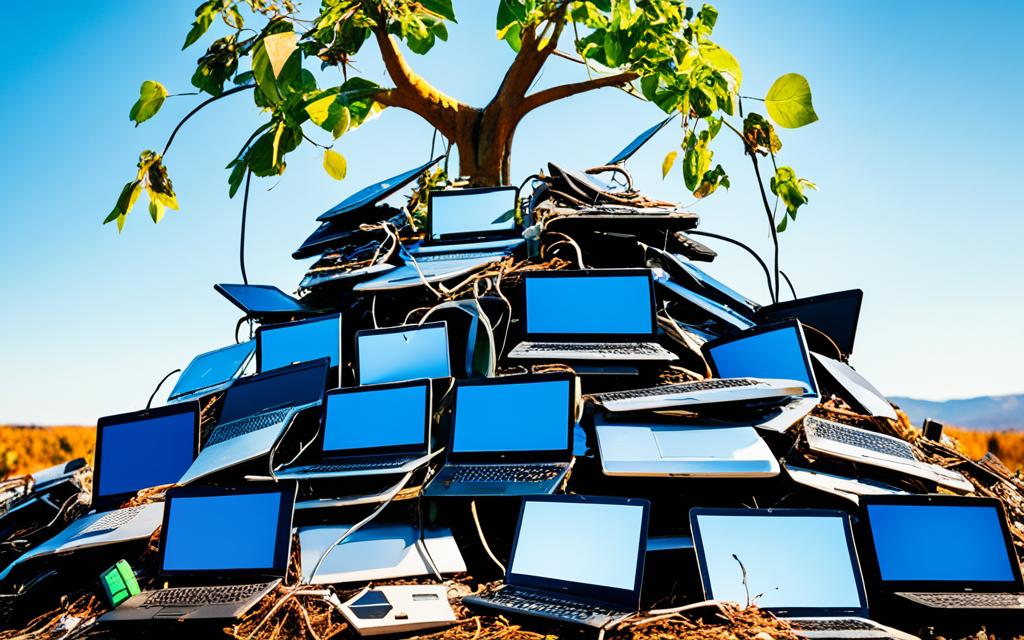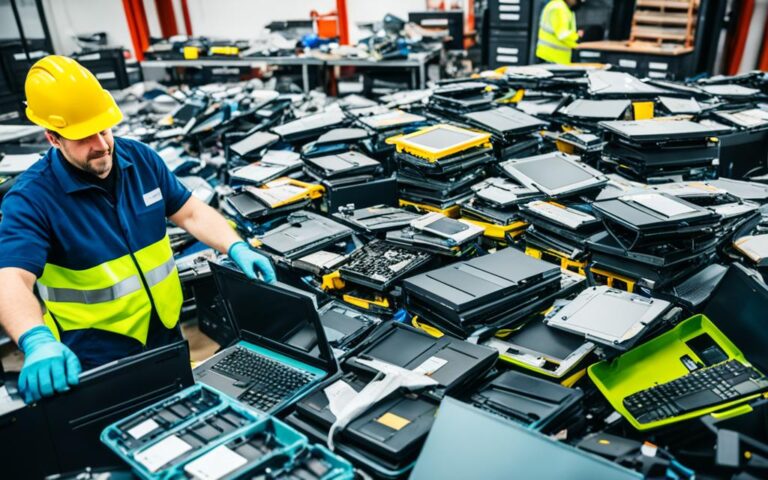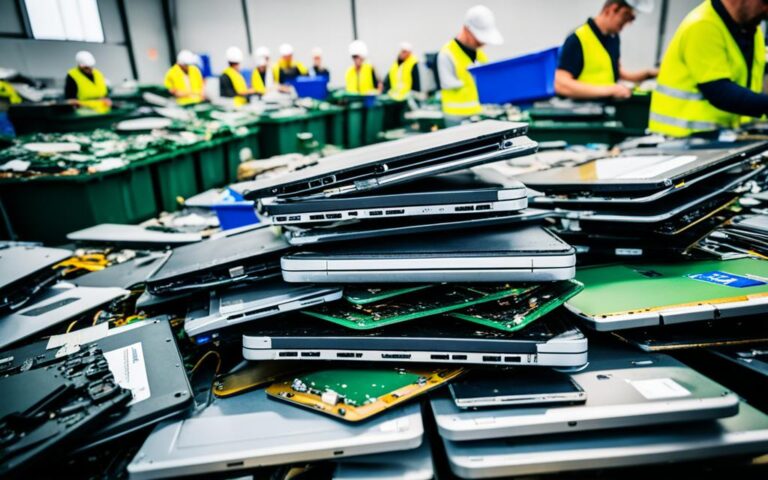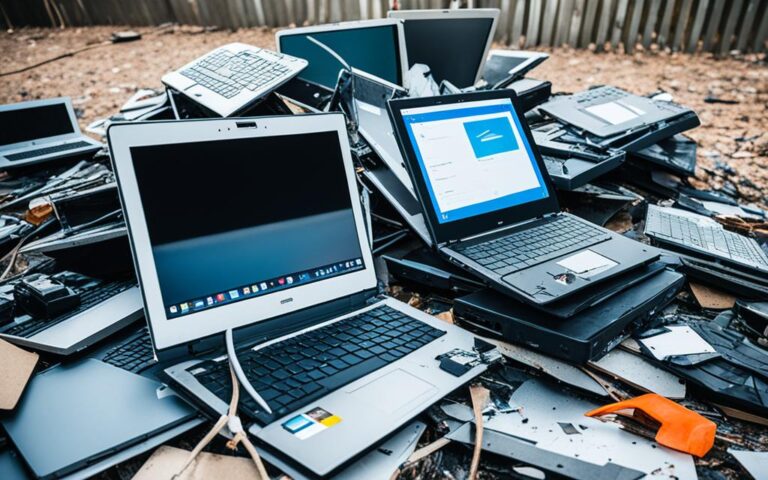The Role of Laptop Recycling in the Fight Against Climate Change
Electronic waste, or e-waste, is a growing concern in the context of climate change. Improper disposal and recycling practices of electronic products contribute significantly to greenhouse gas emissions. The global volume of electronic waste is projected to double by 2030, making it the fastest-growing waste stream. Only a small fraction of e-waste is currently recycled in an environmentally sound manner. Sustainable management of e-waste is crucial for addressing climate change and promoting environmental conservation.
Proper laptop recycling plays a vital role in the fight against climate change. E-waste management strategies, including recycling and reusing electronics, are essential for reducing greenhouse gas emissions and mitigating environmental impacts. Adopting sustainable practices, such as the circular economy concept, can transform e-waste into valuable resources. Increased awareness and education about e-waste’s connection to climate change are necessary for driving positive change. Join the movement towards responsible laptop recycling to promote environmental sustainability and combat climate change. Visit https://it-recycle.uk/server-recycling-uk/ for more information on server recycling in the UK.
The Environmental Impacts of E-Waste
E-waste, short for electronic waste, poses significant environmental risks if not properly managed. With the proliferation of electronic devices and their rapid obsolescence, e-waste has become a growing concern in the context of climate change and environmental conservation.
E-waste contains toxic substances like lead, mercury, and cadmium, which can be released into the environment if not handled appropriately. These hazardous materials can contaminate soil and water, posing serious health risks to humans, wildlife, and ecosystems. Proper disposal and recycling of e-waste are essential to mitigate these environmental impacts and protect our planet.
Burning electronics, a common practice in some areas, releases carbon dioxide (CO2) and other pollutants into the air. These emissions contribute to air pollution and climate change, exacerbating the global warming crisis. The improper incineration of e-waste also releases harmful chemicals, further damaging air quality and human health.
“E-waste recycling prevents the release of harmful substances into the environment, reduces greenhouse gas emissions, and conserves valuable resources.”
Moreover, when e-waste ends up in landfills, it poses additional environmental threats. The toxic components of electronics can leach into the soil and contaminate groundwater, polluting local water sources. This not only harms the environment but also poses risks to communities relying on these water supplies.
| Environmental Impacts of E-Waste | Consequences |
|---|---|
| Release of toxic substances | Soil and water contamination, health risks |
| Air pollution | Contribution to climate change, respiratory issues |
| Landfill contamination | Groundwater pollution, ecosystem disruption |
Given these environmental impacts, it is crucial to prioritize the proper recycling and disposal of e-waste. By implementing effective e-waste management strategies, we can reduce the release of harmful substances, prevent further degradation of the environment, and contribute to the fight against climate change.
Next, we will explore the importance of recycling electronics and how it can help reduce our carbon footprint and greenhouse gas emissions.
The Importance of Recycling Electronics
Recycling electronics plays a vital role in reducing our carbon footprint and greenhouse gas emissions. The production of new electronics generates a significant amount of CO2, contributing to climate change. However, by recycling components from e-waste, we can significantly decrease CO2 emissions by up to 90%. This reduction is achieved by reusing valuable resources that would otherwise require the extraction of raw materials and energy-intensive manufacturing processes.
By recycling and reusing electronics, we can also address the issue of resource scarcity. Electronic devices contain precious metals and rare minerals that can be extracted through environmentally damaging methods. By extending the lifecycle of these materials through recycling, we reduce the demand for new products and the need for further extraction.
Proper recycling of electronics is not only beneficial in terms of reducing our carbon footprint, but it also helps combat climate change. Greenhouse gas emissions, particularly CO2, contribute to global warming and climate-related impacts such as rising temperatures, sea-level rise, and extreme weather events.
Through recycling electronics, we are actively participating in a more sustainable future. By diverting e-waste from landfills and promoting responsible recycling practices, we can minimize the environmental impact of electronic waste and contribute to creating a circular economy. A circular economy mindset emphasizes the reduction, reuse, and recycling of materials, ensuring that resources are kept in use for as long as possible.
“Recycling electronics not only reduces our carbon footprint, but it also helps combat climate change and fosters a more sustainable future.”
By adopting proper recycling practices, we can actively contribute to mitigating the adverse effects of climate change. Recycling electronics is a simple yet effective way to make a positive impact on the environment and support a more sustainable future for generations to come.
E-Waste Recycling Process
Recycling electronics involves a comprehensive process that encompasses various stages:
- Collection: E-waste is collected through dedicated recycling programs or drop-off centers.
- Sorting: The collected e-waste is sorted into different categories, separating devices based on their material composition.
- Dismantling: Electronics are disassembled, separating components that can be reused or recycled.
- Component Recycling: Valuable materials like gold, silver, copper, and palladium are extracted from circuit boards, wires, and other electronic components.
- Safe Disposal of Hazardous Substances: Toxic substances, such as lead and mercury, are safely removed and disposed of to prevent environmental contamination.
- Reassembly or Repurposing: Some components may be refurbished or repurposed for reuse in new electronic devices, extending their lifecycle.
- Proper Disposal: Any remaining materials that cannot be recycled are disposed of in an environmentally responsible manner.
The e-waste recycling process ensures that valuable resources are recovered, hazardous substances are properly managed, and electronic waste is diverted from landfills. By supporting the recycling industry and responsibly disposing of our electronic devices, we contribute to a more sustainable and environmentally friendly future.
The Urgency of E-Waste Management
The global e-waste crisis is escalating rapidly, with a projected doubling of e-waste volume by 2030. Currently, only a small percentage of e-waste is formally collected and recycled. The lack of awareness and education among consumers contributes to the problem. Urgent action is needed to improve e-waste management strategies, including comprehensive regulatory frameworks, advanced recycling technologies, and increased consumer education and awareness.
The Scope of the Global E-Waste Crisis
The global e-waste crisis is a pressing issue that demands immediate attention. According to projections, e-waste volume is expected to double by 2030, exacerbating the environmental and health risks associated with improper disposal and recycling practices.
“The global volume of electronic waste is projected to double by 2030, making it the fastest-growing waste stream.”
This alarming increase in e-waste poses significant challenges for both developed and developing nations. Currently, only a fraction of e-waste is being properly managed and recycled, leading to the accumulation of hazardous materials in landfills and the release of harmful pollutants into the environment.
The Importance of Consumer Education and Awareness
One of the critical factors contributing to the global e-waste crisis is the lack of awareness and education among consumers. Many individuals are unaware of the correct methods for disposing of e-waste or the consequences of improper disposal.
By increasing consumer education and awareness about the importance of e-waste management, we can empower individuals to make informed choices and take responsible actions. Educational campaigns and initiatives can highlight the environmental and health impacts of e-waste and provide guidance on proper disposal and recycling processes.
Regulatory Frameworks and Advanced Recycling Technologies
Comprehensive regulatory frameworks play a crucial role in improving e-waste management. Governments need to implement stringent regulations that incentivize proper e-waste disposal and encourage the adoption of environmentally friendly recycling practices.
Furthermore, advancements in recycling technologies are essential for effective e-waste management. Innovations such as automated dismantling processes, safe extraction of valuable materials, and efficient recycling techniques can significantly enhance the recycling capacity and minimize the environmental impact of e-waste.
E-Waste Management: A Collective Responsibility
Addressing the global e-waste crisis requires a collaborative effort from governments, industries, consumers, and environmental organizations. Each stakeholder has a role to play in developing sustainable e-waste management strategies and promoting responsible consumption and disposal practices.
Together, we can drive positive change, combat the global e-waste crisis, and create a more sustainable future.
| Key Challenges | Proposed Solutions |
|---|---|
| Lack of awareness and education | Implement consumer education campaigns Provide informational resources on e-waste management Promote responsible disposal practices |
| Inadequate regulatory frameworks | Enforce stricter regulations for e-waste disposal Incentivize proper recycling through legislation Encourage industry compliance |
| Insufficient recycling technologies | Invest in research and development of advanced recycling technologies Facilitate collaborations between industry and academia Promote innovation in eco-friendly recycling methods |
| Limited recycling infrastructure | Expand the network of e-waste collection centers Ensure proper recycling facilities are available Partner with private and public entities to establish recycling infrastructure |
Recycling as a Solution for E-Waste
Recycling is a key solution for managing e-waste sustainably. In today’s throwaway culture, where electronic devices are constantly being replaced, recycling offers a way to divert valuable resources from landfills and reduce the environmental impact of electronic waste.
One approach to recycling e-waste is through the implementation of circular economy principles. The circular economy views waste as a valuable resource that can be reused and recycled, rather than simply discarded. By adopting circular economy practices, we can minimize the extraction of raw materials and reduce the energy required to produce new electronic devices. This, in turn, helps mitigate climate change and promotes sustainable practices.
Benefits of Recycling E-Waste
- Environmental Impacts: Recycling e-waste helps prevent hazardous materials, such as lead and mercury, from polluting the environment. These toxins can be released into the air and water when e-waste is improperly disposed of or incinerated. By recycling electronic devices, we can reduce the pollution associated with e-waste and protect our ecosystems.
- Resource Conservation: Recycling allows us to recover valuable materials from discarded electronics. By reusing these materials, we can reduce the need for raw material extraction and minimize the environmental impact of mining and manufacturing processes. Additionally, recycling conserves energy, as producing new electronic devices requires considerably more energy than recycling existing ones.
- Sustainable Practices: Recycling e-waste aligns with sustainable practices by promoting the efficient use of resources and reducing waste generation. It helps create a closed-loop system where materials are continuously recycled and reused, thereby minimizing the need for new production and landfill disposal.
To effectively recycle e-waste, comprehensive recycling programs should be implemented. These programs can include convenient drop-off locations, partnerships with retailers and manufacturers, and public awareness campaigns. Additionally, advancements in recycling technologies and eco-design principles can enhance the efficiency and effectiveness of e-waste recycling processes.
Case Study: E-Waste Recycling Program in ABC Company
“At ABC Company, we are committed to sustainable practices and have implemented an e-waste recycling program to responsibly manage our electronic waste. Through partnerships with certified e-waste recyclers, we ensure that our outdated electronic devices are properly collected, dismantled, and recycled. By participating in this program, we contribute to the circular economy, reduce greenhouse gas emissions, and promote a more sustainable future.”
By recycling e-waste, we not only reduce the environmental impacts associated with improper disposal but also contribute to economic growth and societal progress. The materials recovered from e-waste can be used in the production of new products, creating a more resource-efficient and sustainable economy. It is crucial for individuals, businesses, and governments to embrace e-waste recycling as a solution to the global e-waste crisis and a step towards building a circular economy.
| Benefits of E-Waste Recycling | Example |
|---|---|
| Reduces environmental impacts | Prevents hazardous materials from polluting ecosystems |
| Conserves resources | Reduces the need for raw material extraction |
| Promotes sustainable practices | Creates a closed-loop system for resource management |
| Contributes to economic growth | Recycled materials can be used in new product manufacturing |
The Impact of E-Waste on Climate Change Awareness
E-waste (electronic waste) plays a significant role in the escalating issue of climate change, yet it often goes unnoticed in the broader climate change debate. Consumer awareness regarding e-waste and its impact on the environment remains relatively low. However, it is crucial to raise awareness about the link between e-waste and climate change in order to foster responsible e-waste management practices.
One way to improve climate change awareness is through initiatives that encourage consumers to donate or sell their unwanted electronics for recycling. By participating in these programs, individuals not only contribute to the protection of the environment but also become educated about the significant impact of e-waste on climate change. This education can serve as a catalyst for individuals to take action against e-waste and make informed decisions about electronic consumption and disposal.
“Raising awareness about the connection between e-waste and climate change is crucial for encouraging responsible e-waste management.”
By highlighting the interconnectedness of e-waste and climate change, it becomes evident that proper e-waste management should be a priority for individuals, industries, and governments alike. Implementing effective recycling programs and regulations can help minimize the negative environmental impact caused by e-waste. Furthermore, these efforts can contribute to the development of a circular economy that prioritizes sustainable practices and resource conservation.
Listing the Environmental Impacts of E-Waste:
- Release of toxic substances such as lead, mercury, and cadmium into the environment
- Production of greenhouse gases through burning e-waste
- Contamination of soil and water when e-waste ends up in landfills
By educating individuals about the impact of e-waste on climate change, we can create a collective understanding of the urgency to address e-waste management. By taking action today, we can contribute to a more sustainable future and combat the critical issue of climate change.
Conclusion
Proper laptop recycling plays a vital role in the fight against climate change. By implementing effective e-waste management strategies, including recycling and reusing electronics, we can significantly reduce greenhouse gas emissions and mitigate environmental impacts. It is essential to adopt sustainable practices, such as embracing the circular economy concept, which transforms e-waste into valuable resources.
However, to achieve meaningful change, we need to increase awareness and education about the connection between e-waste and climate change. By understanding the environmental consequences of improper e-waste disposal and supporting responsible laptop recycling, we can drive positive change and promote environmental sustainability.
Join the movement towards responsible laptop recycling to combat climate change. By participating in laptop recycling programs, you contribute to reducing the carbon footprint and conserving valuable resources. Let us work together to create a greener future and protect our planet for generations to come.
FAQ
What is e-waste and why is it a concern in the context of climate change?
E-waste refers to electronic waste, which includes discarded electronic devices. Improper disposal and recycling practices of electronic products contribute significantly to greenhouse gas emissions. The increasing volume of e-waste globally is projected to double by 2030, making it the fastest-growing waste stream.
What are the environmental impacts of e-waste?
E-waste contains toxic substances like lead, mercury, and cadmium, which can be released into the environment if not handled appropriately. Burning electronics releases CO2 and other pollutants that contribute to air pollution and climate change. E-waste that ends up in landfills can contaminate soil and water, posing health risks to humans and wildlife.
How does recycling electronics help combat climate change?
Recycling electronics can help reduce our carbon footprint and greenhouse gas emissions. Producing new electronics generates a significant amount of CO2, while recycling components from e-waste reduces CO2 emissions by 90%. By recycling and reusing electronics, we can decrease the demand for new products and conserve valuable resources.
What is the urgency of e-waste management?
Currently, only a small percentage of e-waste is formally collected and recycled. The lack of awareness and education among consumers contributes to the problem. Urgent action is needed to improve e-waste management strategies, including comprehensive regulatory frameworks, advanced recycling technologies, and increased consumer education and awareness.
How does recycling contribute to sustainable e-waste management?
Recycling is a key solution for managing e-waste sustainably. The circular economy concept views waste as a valuable resource, promoting recycling and reuse instead of disposal. Implementing comprehensive recycling programs, improving recycling technologies, and adopting eco-design principles can help transform e-waste into valuable resources, reducing environmental impacts, and contributing to economic growth.
Why is raising awareness about e-waste and climate change crucial?
E-waste has not received the level of attention it deserves in the climate change debate. Consumer awareness about e-waste and its environmental impacts is relatively low. Raising awareness about the connection between e-waste and climate change is crucial for encouraging responsible e-waste management. Initiatives like donating or selling unwanted electronics for recycling can help educate consumers and incentivize them to take action against e-waste.
What role does laptop recycling play in the fight against climate change?
Proper laptop recycling plays a vital role in the fight against climate change. E-waste management strategies, including recycling and reusing electronics, are essential for reducing greenhouse gas emissions and mitigating environmental impacts. Adopting sustainable practices, such as the circular economy concept, can transform e-waste into valuable resources. Increased awareness and education about e-waste’s connection to climate change are necessary for driving positive change.













